Articles by Sherman Horn III
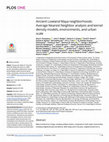
PLoS One, 2022
Many humans live in large, complex political centers, composed of multi-scalar communities includ... more Many humans live in large, complex political centers, composed of multi-scalar communities including neighborhoods and districts. Both today and in the past, neighborhoods form a fundamental part of cities and are defined by their spatial, architectural, and material elements. Neighborhoods existed in ancient centers of various scales, and multiple methods have been employed to identify ancient neighborhoods in archaeological contexts. However, the use of different methods for neighborhood identification within the same spatiotemporal setting results in challenges for comparisons within and between ancient societies. Here, we focus on using a single method—combining Average Nearest Neighbor (ANN) and Kernel Density (KD) analyses of household groups—to identify potential neighborhoods based on clusters of households at 23 ancient centers across the Maya Lowlands. While a
one-size-fits all model does not work for neighborhood identification everywhere, the ANN/KD method provides quantifiable data on the clustering of ancient households, which can be linked to environmental zones and urban scale. We found that centers in river valleys exhibited
greater household clustering compared to centers in upland and
escarpment environments. Settlement patterns on flat plains were more dispersed, with little discrete spatial clustering of households. Furthermore, we categorized the ancient Maya centers into discrete
urban scales, finding that larger centers had greater variation in household spacing compared to medium-sized and smaller centers. Many larger political centers possess heterogeneity in household clustering between their civic-ceremonial cores, immediate hinterlands, and far peripheries. Smaller centers exhibit greater household clustering compared to larger ones. This paper quantitatively assesses household clustering among nearly two dozen centers across the Maya Lowlands, linking environment and urban scale to settlement patterns. The findings are applicable to ancient societies and modern cities alike; understanding how humans form multi-scalar social groupings, such as neighborhoods, is fundamental to human experience and social organization.

Journal of Field Archaeology, 2020
Excavations in northeastern Belize have generated one of the more detailed regional databases of ... more Excavations in northeastern Belize have generated one of the more detailed regional databases of Middle Preclassic (1000–350 B.C.) settlement in the Maya Lowlands, providing the basis for developmental models of later Maya civilization. Modest Classic period architecture permitted extensive exposures of early occupations at several sites, but contemporaneous settlements at large, later centers remain poorly understood, despite the insights they may offer into emergent
social complexity and political hierarchy. We review extant and unpublished data from Lamanai and Altun Ha, two large centers in northeastern Belize during Classic times, to compare aspects of
Middle Preclassic settlement, architecture, and burial practices and to evaluate how this evidence relates to existing models of early Maya community development. Comparisons between these sites and among other Middle Preclassic settlements beyond northeastern Belize suggest a more nuanced approach to understanding developing social complexity in the Maya Lowlands, which acknowledges regional similarities and variability, is warranted.
El Paisaje Urbano Maya: del Preclásico al Virreinato, 2020
Ancient Maya centers, such as Tikal and El Pilar, emerged where vital well-drained uplands with p... more Ancient Maya centers, such as Tikal and El Pilar, emerged where vital well-drained uplands with productive soils attracted farmers. Farmers living in the woodlands of the Maya region developed home gardens, where dynamic milpa crops and orchards were intensified as infields around homes. This created a subsistence matrix that built soil fertility, conserved water, managed resources, and fed people while maintaining ecological sustainability and increasing the cultural prosperity of Maya civilization. We draw examples from long term research at El Pilar to discuss
relationships between land use, population, and environment in the Maya Lowlands.
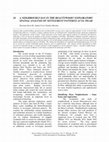
Research Reports in Belizean Archaeology V. 17, 2020
Ongoing Lidar ground-truthing operations have produced full coverage survey maps for approximatel... more Ongoing Lidar ground-truthing operations have produced full coverage survey maps for approximately 12 km 2 of the El Pilar Archaeological Reserve, revealing a complex settlement mosaic of residential units, monumental groups, landscape modification features, and apparently vacant terrain. Visual inspection of the master map suggests patterns of settlement and land use, reflecting a series of choices by members of the ancient community at El Pilar. Residential settlement generally conforms to favorable topography, but the distribution of smaller monumental groups, and the apparent concentrations of domestic structures on other types of terrain suggest social factors played a role in determining settlement location. This paper presents exploratory spatial analyses of settlement patterns at El Pilar. We examine the distribution of residential and monumental groups across the site to search for socially meaningful spatial divisions, such as neighborhoods. Our analyses include information on labor invested in residential groups to examine potential wealth inequalities in local settlement clusters-possible neighborhoods-and to explore how people of different social statuses populated the landscape at El Pilar.
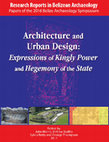
Archaeological investigations at the major center of El Pilar have revealed a complex archaeologi... more Archaeological investigations at the major center of El Pilar have revealed a complex archaeological history. Since its
rediscovery, not only has there been research, but this year we celebrate 1 baktun, 20 years, of protection and the development of institutional management featuring “Archaeology Under the Canopy.” The research contributions include surface surveys, excavations, consolidation of buildings, and the study of vegetation. Prehispanic occupation of the area dates from the Middle
Preclassic to the Terminal Classic with vestiges of Postclassic. Today, a contiguous reserve in Belize and Guatemala incorporate 20 km2. The use of traditional techniques in research and the implementation of modern LiDAR technology, allow us to review interpretative models for the study of ancient settlements and monuments as well as the use and management of natural resources. We present a summary of the research and development carried out to date on and the results that contribute to the
understanding of the past and present of the El Pilar Archaeological Reserve for Maya Flora and Fauna.
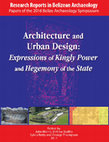
Investigations of Middle Preclassic communities in Belize rely heavily on architectural analysis,... more Investigations of Middle Preclassic communities in Belize rely heavily on architectural analysis, as the remains of ancient structures represent one of the largest and most durable categories of material culture from this period. Architecture can reflect patterns in social organization and interaction, and comparisons of architectural investment have frequently been used to identify differences in status among social groups. Excavations at Cahal Pech by the Belize Valley Archaeological Project revealed an unexpected level of variability among several Middle Preclassic architectural features and construction sequences beneath Plaza B. Construction activity in Plaza B resembled neither the carefully planned monumental templates of Middle Preclassic Petén communities nor the incremental superposition of domestic platforms found in northern Belize, but was rather a punctuated equilibrium of building “events” that occurred at different tempos in different areas. Differential investment in architecture suggests that social relationships at Middle Preclassic Cahal Pech may have been more fluid and dynamic than
would be expected in a community where social rank was hereditary and well established. This paper synthesizes Middle Preclassic architectural data from beneath Plaza B and explores their implications for understanding the development of social complexity in the Maya Lowlands.

Over the past twenty years our understanding of the Middle Preclassic (900–300 BCE) period has be... more Over the past twenty years our understanding of the Middle Preclassic (900–300 BCE) period has become much clearer through archaeological investigations at a number of sites located in the Upper Belize River Valley region of the eastern Maya Lowlands. While the picture of Middle Preclassic Maya life, including their material culture, has sharpened, there are aspects that remain uninvestigated. One artifact type, identified as greenstone triangulates, has been found at several Belize Valley sites and in a variety of contexts. Although a number of these multifaceted,
polished groundstone items have been recovered, little research has focused on their distribution and function in the archaeological record. An evaluation of these items from primary contexts provides data for determining how they were used in daily social and/or ritual activities throughout the lowlands. Comparative data from other regions of Mesoamerica are also discussed. A detailed geological and petrographic pilot study of a sample of greenstone triangulates is provided, pointing conclusively to early, long-distance and complex exchange networks in exotic raw materials.
Follow the linked URL for free access before November 11th, 2016. After that date, I will be happy to provide copies for personal use upon request. - SH
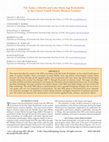
This report describes the results of the 2009 excavations at the Erb Tanks Rockshelter on the cen... more This report describes the results of the 2009 excavations at the Erb Tanks Rockshelter on the central Namib gravel
plain in western Namibia. These excavations revealed Middle Stone Age (MSA) archaeological remains dated
between 130–45 ka through ostrich eggshell amino acid racemization and Later Stone Age (LSA) archaeological
remains dating from around 5 ka through AMS 14C through the period of colonial contact. This paper describes
our field methods and offers information concerning site formation and post-depositional processes. In describing
the lithic assemblage, this paper proposes two distinct phases of the MSA and subtle change over time in the LSA
lithic technology. The earlier MSA phase is characterized by more expedient knapping strategies, the use of local
vein quartz, and very low frequencies of end-products. The later MSA phase is characterized by more elaborate
core reduction strategies, the exploitation of more distant dolerite, and higher frequencies of technical end-products.
This report also discusses the characteristics of LSA ostrich eggshell beads, ceramics, and historic objects.
Presentations by Sherman Horn III
A half-century of targeted excavations in northern Belize has generated one of the most detailed ... more A half-century of targeted excavations in northern Belize has generated one of the most detailed databases of Middle Preclassic (900 -350 B.C.) settlement in the Maya Lowlands. Information from sites such as Cuello, K'axob, and Colha has provided the basis for economic and political models of Preclassic development in northern Belize and the eastern Maya Lowlands in general.
Continuous building over preexisting structures complicates early settlement and social organizat... more Continuous building over preexisting structures complicates early settlement and social organization studies in the Maya Lowlands. Archaeologists are often compelled to interpret deeply buried and partially demolished architecture through the narrow window provided by test units, which greatly increases the role received knowledge plays in synthesizing organizational and developmental models from this information. This paper discusses variability in architecture and artifact distributions from Middle Preclassic construction loci beneath Plaza B at Cahal Pech, Belize, which defies many of these preconceived assumptions. It further suggests that more caution is warranted when investigating this important developmental period in lowland Maya prehistory.
Papers by Sherman Horn III
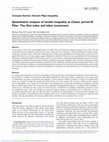
Ancient Mesoamerica, 2023
Survey teams at the El Pilar Archaeological Reserve for Maya Flora and Fauna have mapped 70 perce... more Survey teams at the El Pilar Archaeological Reserve for Maya Flora and Fauna have mapped 70 percent of its 20 km 2 area and revealed the extent of settlement around the city center. Large-scale civic architecture, and the distribution of smaller ceremonial groups and minor centers, reflect the wealth and power of Maya rulers presiding over the largest Classic period city in the upper Belize River area. Previous analyses suggest disparities in wealth at El Pilar were more nuanced than the elite/commoner dichotomy commonly invoked for Classic Maya society. This article works to understand wealth inequality at ancient El Pilar by computing Gini coefficients from areal and volumetric calculations of primary residential units-the class of settlement remains most likely to represent ancient households. Presentation of Gini coefficients and their potential interpretations follows a discussion of settlement classification and residential group labor investment. We conclude by contextualizing these results within prior settlement pattern analyses to explore how disparities in wealth may have been distributed across the physical and social landscape. Resumen Los equipos de investigación en la Reserva Arqueológica El Pilar para la Flora y Fauna Maya han mapeado el 70 por ciento de su área de 20 km 2 y revelaron la extensión del asentamiento alrededor del centro de la ciudad. La arquitectura cívica a gran escala, y la distribución de grupos ceremoniales más pequeños y centros menores, reflejan la riqueza y el poder de los gobernantes mayas que presiden la ciudad más grande del período clásico en el área superior del río Belice. Análisis previos sugieren que las disparidades en la riqueza en El Pilar fueron más matizadas que la dicotomía élite/plebeyo comúnmente invocada para la sociedad maya clásica. Este artículo trata de comprender la desigualdad de riqueza en el antiguo El Pilar mediante el cálculo de los coeficientes de Gini a partir de cálculos de área y volumétricos de unidades residenciales primarias: la clase de asentamiento sigue siendo más probable que represente hogares antiguos. La presentación de los coeficientes de Gini y sus posibles interpretaciones sigue una discusión sobre la clasificación de asentamientos y la inversión laboral del grupo residencial. Concluimos contextualizando estos resultados dentro de los análisis de patrones de asentamiento anteriores para explorar cómo las disparidades en la riqueza pueden haberse distribuido en el panorama físico y social.
The 81st Annual Meeting of the Society for American Archaeology, 2016
The 84th Annual Meeting of the Society for American Archaeology, 2019
The 80th Annual Meeting of the Society for American Archaeology, 2015
The 86th Annual Meeting of the Society for American Archaeology, 2021
The 86th Annual Meeting of the Society for American Archaeology, 2021
Uploads
Articles by Sherman Horn III
one-size-fits all model does not work for neighborhood identification everywhere, the ANN/KD method provides quantifiable data on the clustering of ancient households, which can be linked to environmental zones and urban scale. We found that centers in river valleys exhibited
greater household clustering compared to centers in upland and
escarpment environments. Settlement patterns on flat plains were more dispersed, with little discrete spatial clustering of households. Furthermore, we categorized the ancient Maya centers into discrete
urban scales, finding that larger centers had greater variation in household spacing compared to medium-sized and smaller centers. Many larger political centers possess heterogeneity in household clustering between their civic-ceremonial cores, immediate hinterlands, and far peripheries. Smaller centers exhibit greater household clustering compared to larger ones. This paper quantitatively assesses household clustering among nearly two dozen centers across the Maya Lowlands, linking environment and urban scale to settlement patterns. The findings are applicable to ancient societies and modern cities alike; understanding how humans form multi-scalar social groupings, such as neighborhoods, is fundamental to human experience and social organization.
social complexity and political hierarchy. We review extant and unpublished data from Lamanai and Altun Ha, two large centers in northeastern Belize during Classic times, to compare aspects of
Middle Preclassic settlement, architecture, and burial practices and to evaluate how this evidence relates to existing models of early Maya community development. Comparisons between these sites and among other Middle Preclassic settlements beyond northeastern Belize suggest a more nuanced approach to understanding developing social complexity in the Maya Lowlands, which acknowledges regional similarities and variability, is warranted.
relationships between land use, population, and environment in the Maya Lowlands.
rediscovery, not only has there been research, but this year we celebrate 1 baktun, 20 years, of protection and the development of institutional management featuring “Archaeology Under the Canopy.” The research contributions include surface surveys, excavations, consolidation of buildings, and the study of vegetation. Prehispanic occupation of the area dates from the Middle
Preclassic to the Terminal Classic with vestiges of Postclassic. Today, a contiguous reserve in Belize and Guatemala incorporate 20 km2. The use of traditional techniques in research and the implementation of modern LiDAR technology, allow us to review interpretative models for the study of ancient settlements and monuments as well as the use and management of natural resources. We present a summary of the research and development carried out to date on and the results that contribute to the
understanding of the past and present of the El Pilar Archaeological Reserve for Maya Flora and Fauna.
would be expected in a community where social rank was hereditary and well established. This paper synthesizes Middle Preclassic architectural data from beneath Plaza B and explores their implications for understanding the development of social complexity in the Maya Lowlands.
polished groundstone items have been recovered, little research has focused on their distribution and function in the archaeological record. An evaluation of these items from primary contexts provides data for determining how they were used in daily social and/or ritual activities throughout the lowlands. Comparative data from other regions of Mesoamerica are also discussed. A detailed geological and petrographic pilot study of a sample of greenstone triangulates is provided, pointing conclusively to early, long-distance and complex exchange networks in exotic raw materials.
Follow the linked URL for free access before November 11th, 2016. After that date, I will be happy to provide copies for personal use upon request. - SH
plain in western Namibia. These excavations revealed Middle Stone Age (MSA) archaeological remains dated
between 130–45 ka through ostrich eggshell amino acid racemization and Later Stone Age (LSA) archaeological
remains dating from around 5 ka through AMS 14C through the period of colonial contact. This paper describes
our field methods and offers information concerning site formation and post-depositional processes. In describing
the lithic assemblage, this paper proposes two distinct phases of the MSA and subtle change over time in the LSA
lithic technology. The earlier MSA phase is characterized by more expedient knapping strategies, the use of local
vein quartz, and very low frequencies of end-products. The later MSA phase is characterized by more elaborate
core reduction strategies, the exploitation of more distant dolerite, and higher frequencies of technical end-products.
This report also discusses the characteristics of LSA ostrich eggshell beads, ceramics, and historic objects.
Presentations by Sherman Horn III
Papers by Sherman Horn III
one-size-fits all model does not work for neighborhood identification everywhere, the ANN/KD method provides quantifiable data on the clustering of ancient households, which can be linked to environmental zones and urban scale. We found that centers in river valleys exhibited
greater household clustering compared to centers in upland and
escarpment environments. Settlement patterns on flat plains were more dispersed, with little discrete spatial clustering of households. Furthermore, we categorized the ancient Maya centers into discrete
urban scales, finding that larger centers had greater variation in household spacing compared to medium-sized and smaller centers. Many larger political centers possess heterogeneity in household clustering between their civic-ceremonial cores, immediate hinterlands, and far peripheries. Smaller centers exhibit greater household clustering compared to larger ones. This paper quantitatively assesses household clustering among nearly two dozen centers across the Maya Lowlands, linking environment and urban scale to settlement patterns. The findings are applicable to ancient societies and modern cities alike; understanding how humans form multi-scalar social groupings, such as neighborhoods, is fundamental to human experience and social organization.
social complexity and political hierarchy. We review extant and unpublished data from Lamanai and Altun Ha, two large centers in northeastern Belize during Classic times, to compare aspects of
Middle Preclassic settlement, architecture, and burial practices and to evaluate how this evidence relates to existing models of early Maya community development. Comparisons between these sites and among other Middle Preclassic settlements beyond northeastern Belize suggest a more nuanced approach to understanding developing social complexity in the Maya Lowlands, which acknowledges regional similarities and variability, is warranted.
relationships between land use, population, and environment in the Maya Lowlands.
rediscovery, not only has there been research, but this year we celebrate 1 baktun, 20 years, of protection and the development of institutional management featuring “Archaeology Under the Canopy.” The research contributions include surface surveys, excavations, consolidation of buildings, and the study of vegetation. Prehispanic occupation of the area dates from the Middle
Preclassic to the Terminal Classic with vestiges of Postclassic. Today, a contiguous reserve in Belize and Guatemala incorporate 20 km2. The use of traditional techniques in research and the implementation of modern LiDAR technology, allow us to review interpretative models for the study of ancient settlements and monuments as well as the use and management of natural resources. We present a summary of the research and development carried out to date on and the results that contribute to the
understanding of the past and present of the El Pilar Archaeological Reserve for Maya Flora and Fauna.
would be expected in a community where social rank was hereditary and well established. This paper synthesizes Middle Preclassic architectural data from beneath Plaza B and explores their implications for understanding the development of social complexity in the Maya Lowlands.
polished groundstone items have been recovered, little research has focused on their distribution and function in the archaeological record. An evaluation of these items from primary contexts provides data for determining how they were used in daily social and/or ritual activities throughout the lowlands. Comparative data from other regions of Mesoamerica are also discussed. A detailed geological and petrographic pilot study of a sample of greenstone triangulates is provided, pointing conclusively to early, long-distance and complex exchange networks in exotic raw materials.
Follow the linked URL for free access before November 11th, 2016. After that date, I will be happy to provide copies for personal use upon request. - SH
plain in western Namibia. These excavations revealed Middle Stone Age (MSA) archaeological remains dated
between 130–45 ka through ostrich eggshell amino acid racemization and Later Stone Age (LSA) archaeological
remains dating from around 5 ka through AMS 14C through the period of colonial contact. This paper describes
our field methods and offers information concerning site formation and post-depositional processes. In describing
the lithic assemblage, this paper proposes two distinct phases of the MSA and subtle change over time in the LSA
lithic technology. The earlier MSA phase is characterized by more expedient knapping strategies, the use of local
vein quartz, and very low frequencies of end-products. The later MSA phase is characterized by more elaborate
core reduction strategies, the exploitation of more distant dolerite, and higher frequencies of technical end-products.
This report also discusses the characteristics of LSA ostrich eggshell beads, ceramics, and historic objects.